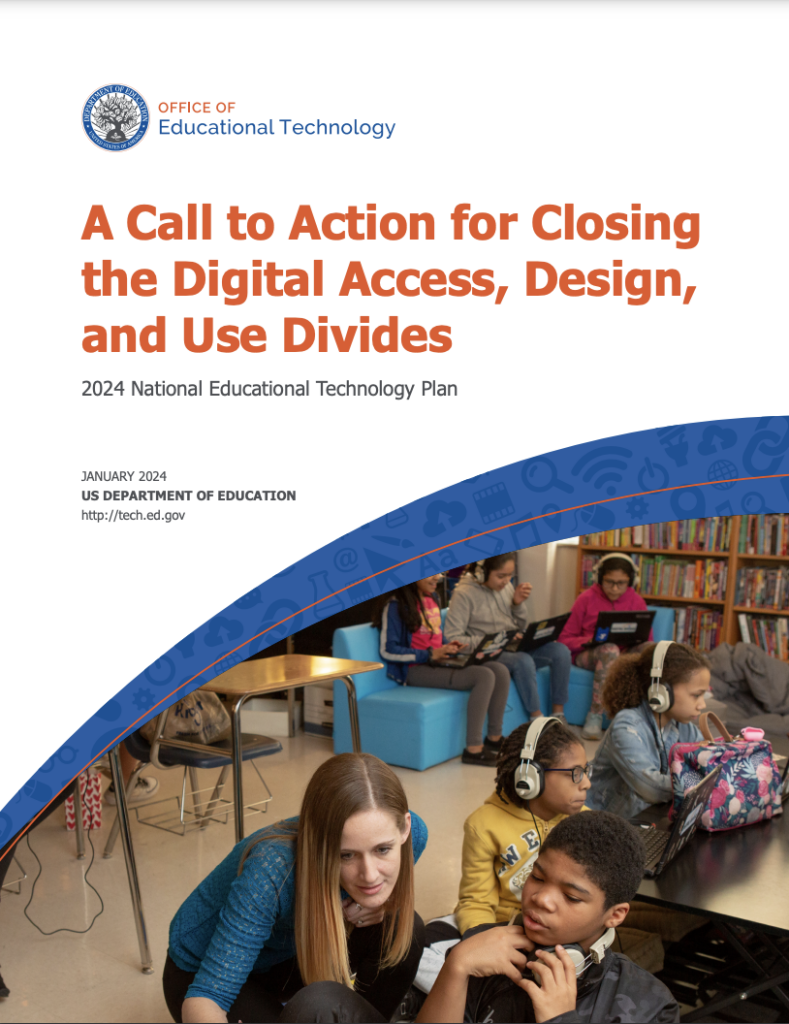In late January, the U.S. Department of Education released its newly revised 2024 National Educational Technology Plan (NETP), and its main talking points centered on inequities. In the report, the DoE emphasized the critical need for educators and communities to address the disparities that currently limit edtech’s potential to transform teaching and learning.

Specifically, the NETP identified three edtech barriers to equity that need to be addressed:
- Digital use divide. This barrier refers to the inequitable implementation in how students use technology. For example, students in some districts are instructed to actively use edtech apps in the classroom, collaborating with other students or creating content, while other students may find themselves only using edtech passively to complete an assignment or an exam.
- Digital design divide: This barrier represents the inequitable access to professional learning for teachers and others to better understand the power of edtech tools and solutions in designing lesson plans for the classroom.
- Digital access divide: The third barrier addresses the inequitable access to reliable internet connectivity, as well as access to tech devices and digital content. Additionally, this categorization also includes the availability and access of content and tech solutions centering on digital citizenship, digital health, and online safety.
First Revision of the NETP in Seven Years
Last month’s revision was the first made to the NETP since January 2017. With this new revision, the Department of Education outlined recommendations for education leaders at the state, district, and school levels to address edtech disparities and close the three identified divides.
Below, please find an outline overview of the Department of Education’s recommendations to address each of the inequitable divides, along with its accountable constituent (state, district, and/or school).

Closing the Digital Use Divide
- Develop a “Profile of a Learner/Graduate” outlining cognitive, personal, and interpersonal competencies students should have when transitioning between grade levels and graduation (States, Districts).
- Design and sustain systems, including needs assessments, technology plans, and evaluation processes supporting the development of competencies outlined in the “Profile of a Learner/Graduate” through the active use of technology to support learning (States, Districts, Schools).
- Implement feedback mechanisms that empower students to become co-designers of learning experiences (Districts, Building-Level Administrators).
- Develop rubrics for digital resource and technology adoption to ensure that tools are accessible and integrated into the larger educational ecosystem, that they support Universal Design for Learning (UDL) principles, and that they can be customized in response to accommodation or modification needs of learners with disabilities (States, Districts, Building-Level Administrators).
- Review subject area curricula or program scopes and sequences to ensure that student learning experiences build age-appropriate digital literacy skills through active technology use for learning (States, Districts).
- Build public-private partnerships with local businesses, higher education institutions, and nonprofit organizations to help students access edtech-enabled hands-on learning and work-based learning experiences (States, Districts).
- Provide professional learning and technical assistance to district leaders, building-level administrators, and educators to support the use of evidence to inform edtech use (States, Districts).
- Develop guidelines for emerging technologies which protect student data privacy and ensure alignment with shared educational vision and learning principles (States, Districts).
Closing the Digital Design Divide
Recommendations to close the digital design divide include:
- Develop a “Portrait of an Educator” outlining the cognitive, personal, and interpersonal competencies educators should have to design learning experiences that help students develop the skills and attributes outlined in the profile of a graduate (States, Districts).
- Design and sustain systems that support ongoing learning for new and veteran teachers and administrators, providing them with the time and space needed to design learning opportunities aligned with the Universal Design for Learning (UDL) Framework (States, Districts, Building-Level Administrators).
- Implement feedback mechanisms that empower educators to become leaders and co-designers of professional learning experiences (Districts, Building-Level Administrators).
- Provide educators and administrators with professional learning that supports the development of digital literacy skills so that they can model these skills for students and the broader school community (States, Districts, Building-Level).
- Develop processes for evaluating the potential effectiveness of digital tools before purchase, including the use of research and evidence (State, District, Building-Level Administrators).
- Foster an inclusive technology ecosystem that solicits input from diverse stakeholders to collaborate on decision-making for technology purchases, learning space design, and curriculum planning (States, Districts, Building-Level Administrators).
- Support and facilitate a systemic culture that builds trust and empowers educators to enhance and grow their professional practice to meet the needs of each student (States, Districts, Building-Level Administrators).
- Regularly solicit educator feedback and evaluate professional learning efforts to ensure alignment with the Portrait of an Educator (District, Building-Level Administrators).
Summary
The revised NETP is a must-read for all school board members, superintendents, administrators, and IT leaders. Simply, the report delivers a no-holds-barred view of the vast potential to improve learning and teaching for every student and teacher.
Driven by a mandated response to the global COVID-19 pandemic, schools now have more connectivity, connected devices, and digital learning resources than ever. More than being problematic, today’s digitally empowered learning environment could be viewed as opportunistic.
Lightspeed Systems is here to usher its customers into a more equitable and, ultimately, effective digital learning ecosystem with innovative solutions like Lightspeed Digital Insight™ and its Digital Equity Module. For more information, schedule a quick and easy demo today.

